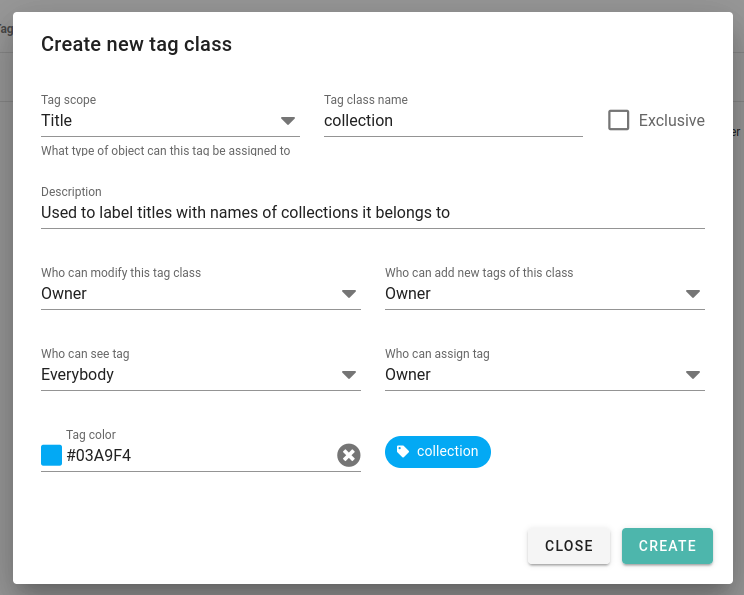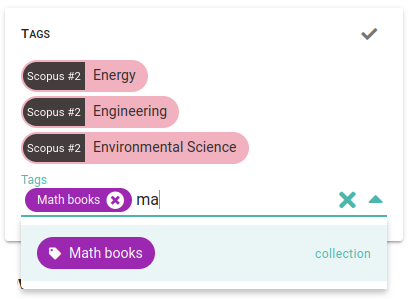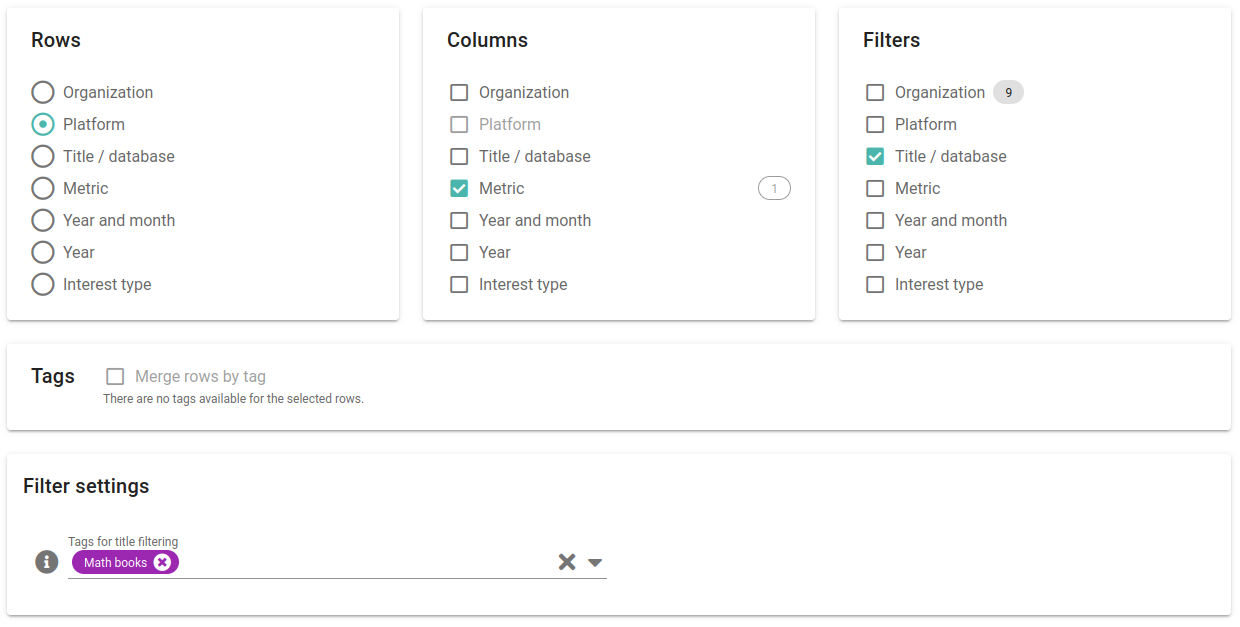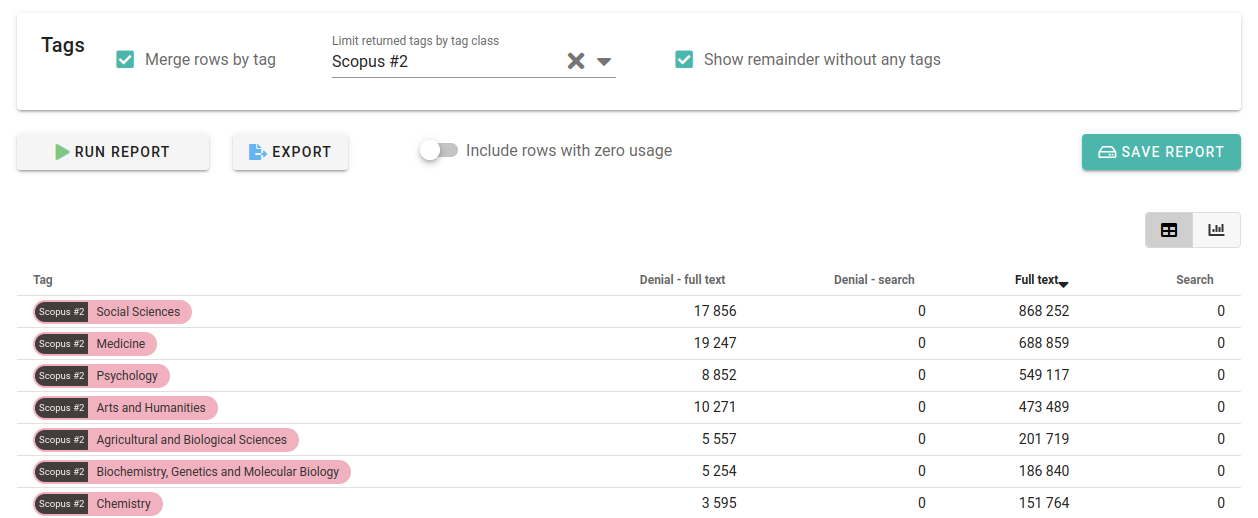Tags are a new feature introduced in Celus 5.0 which allows users to attach arbitrary labels to individual titles, platforms and organizations.
Tags may be used for filtering of the corresponding lists (list of titles, platforms, organizations) and in the reporting module.
Use cases
Tags are a generic feature which can be used for a variety of purposes. Some of the use cases are:
tagging titles by collection to compute statistics for the whole collection
tagging titles by topic or subject area for purposes of filtering or statistics
tagging of member institutions by organization type, membership type, etc.
ad-hoc tagging of individual titles to enable their comparison in the reporting module
Grouping of tags - tag classes
Because there are many different purposes for using tags, it is important to have a way of organizing them. In Celus this is accomplished by the so called tag classes which are similar to folders and represent one specific type of tag. For example one tag class for titles could be “collection”, which would contain several tags named by individual collections, while another would be “topic” with tags like “chemistry”, “biology”, etc.
Exclusive tags
While you can assign as many tags to an item as you wish, there are specific types of labels for which individual values are mutually exclusive. For example you might want to split you member institutions between public libraries and university libraries. To ensure that it would not be possible to assign both tags to one institution, you can mark the corresponding tag class as exclusive and Celus will enforce the mutual exclusiveness of individual tags.
One important feature of tags from exclusive class is that when you compute usage by individual tags, you can safely sum it up to produce a meaningful total.
Access rights
There are four types of permissions / access rights which influence the behavior of tags:
Assigned to | Action | Desciption |
|---|---|---|
Tag class | edit | Who can edit and/or delete a tag class |
Tag class | add tags | Who can add new tags to a class, modify existing tags and delete them |
Tag | assign to items | Who can assign a tag to individual items, such as titles, platforms, etc. |
Tag | view | Who can see the tag in the user interface |
Each of these access rights can have several values:
Value | Description |
|---|---|
Everybody | Every logged in user can perform the action |
Organization members | Only members of a specified organization can perform the action |
Organization admins | Only administrators or specified organization can perform the action |
Consortium admins | Only consortium administrators can perform the action |
Owner | Only the owner/creator of the tag/tag class can perform the action |
System | No user can perform the action, it is reserved internally for Celus |
Combining the above access rights with different values allows creating tags for a wide variety of use cases. Here are some examples:
Consortium admins can tag each organization by their subscription status without anybody else being able to see the tags.
Consortium admins can tag titles by the name of a collection. All users will be able to see the tags and use them for filtering, but only consortium admins will be able to modify the assignments.
Organization admins can create a set tags which would express importance of a specific title and let their users assign them to individual titles. The tags would be only visible inside the organization at hand.
Any user can create tags for his/her personal use and then use them for ad-hoc filtering of titles in the reporting module.
Creating tags
Tags are managed in the “Tags” section of the main menu. Before you can start using tags, you need to create at least one tag class and at least one tag.

To create a tag class, use the “Create tag class” button as shown above.

Please note that a tag class has always a scope assigned to it. It specifies to which type of items the tags in the class can be assigned. For example, you can create a tag class for titles by assigning it the scope “Titles”. Tags of this class can only be used for titles, not for example platform.
See Exclusive tags above for more information about the “Exclusive” checkbox.
When you create a new tag class, do not be alarmed that it does not show in the list of tags. Only tag classes containing at least one tag are shown in the list. To add a tag to a class, use the “Add tag” button.

After you create new tag, it will be automatically shown in the list of existing tags:

You can create as many tags as you wish. To edit a tag, click on the “Edit” button next to it. When you create a tag, it will inherit the color from the tag class. You can choose a different color when creating or editing a tag.
Assigning tags
Tags are assigned to individual items on the detail page of the item. For example, to assign a tag to a title, go to the detail page of the title and click the “Edit” icon on the “Tags” card.

You will be presented with a list of all tags with scope “Title” and you can select the ones you want to assign to the title.

The assignment is finalized when you hit the checkmark icon in the top right corner of the card.
Filtering by tags
The lists of titles, platforms and organizations can be filtered by tags. On each of these pages, you will find a “Tags” card which allows you to select the tags you want to filter by.

After you select the tags, the list will be filtered to show only the items which have at least one of the selected tags assigned.

Using tags in reporting
The reporting module allows you to use tags for both filtering and grouping of the data.
Filtering
When you select to filter by any of the “taggable” items (titles, platforms, organizations), you will be presented with a list of all tags with the corresponding scope.

The filter will be applied regardless of whether the item is used in rows, columns or neither of them. For example, if you select a tag “Math books” for filtering titles and then configure the report to have platforms in rows and metrics in columns, the report will show only the usage of titles with the tag “Math books” for each platform.
Grouping
When you configure you report to have on of the “taggable” items in rows, a checkbox “Merge rows by tag” will appear. If you check it, instead of getting individual items in rows, you will get one fow per tag of the corresponding scope. In this case it is also possible to limit the shown tags to only those of a specific tag class.
So, if you have for example tagged titles with the topic, you can create a report where each topic will be shown in a separate row.

Note: Please note that unless the corresponding tag class is marked as “exclusive”, the usage of each item will be counted for each tag it has assigned.
Because it is very unlikely (especially for titles) that you will have each title tagged, it may be of interest to see the usage of titles which are not tagged. To do so, you can check the “Show remainder without any tag” checkbox and usage of all items which are not covered by the shown tags will be shown in a separate row at the bottom of the table.
 Please note that if you limit the shown tags to a specific tag class, the “remainder” row will contain the usage of items which are not tagged with any of the tags of the selected class - regardless of whether they have other tags assigned.
Please note that if you limit the shown tags to a specific tag class, the “remainder” row will contain the usage of items which are not tagged with any of the tags of the selected class - regardless of whether they have other tags assigned.Tagging titles in bulk
Frequently, there's a need to tag multiple titles simultaneously, often entire collections. CELUS simplifies this by offering two bulk tagging options: applying a single tag to a full title list or assigning individual titles different tags. In both cases, prepare your title list in Excel format. For uniform tagging of the entire list, no "tag" column is required. To tag specific titles with distinct tags, include the corresponding tags in the "tag" column next to the titles.
1. Click on "Title lists" in the left side menu:

2. Click on the "UPLOAD A NEW TITLE LIST" button:

3. In the following dialog, you can choose to tag all titles by the same (already existing) tag, or assigning different tags from the title list. Choose the option that suits you and upload the source file.

4. You will now see a preview of recognized data. If everything looks correct to you, click on "ASSIGN TAGS" to proceed.

5. Your tags are now assigned. You can choose to have the tags reassigned automatically every month in case more titles from the Title list appear in your CELUS in the future by enabling the "Automatic regular re-processing" slider. You can also reassign the tags manually by clicking on the "REASSIGN" button.

Was this article helpful?
That’s Great!
Thank you for your feedback
Sorry! We couldn't be helpful
Thank you for your feedback
Feedback sent
We appreciate your effort and will try to fix the article
